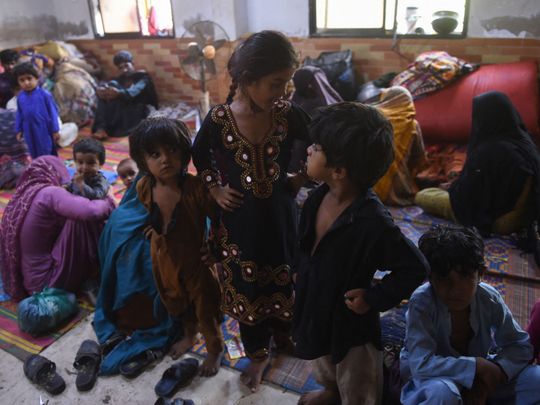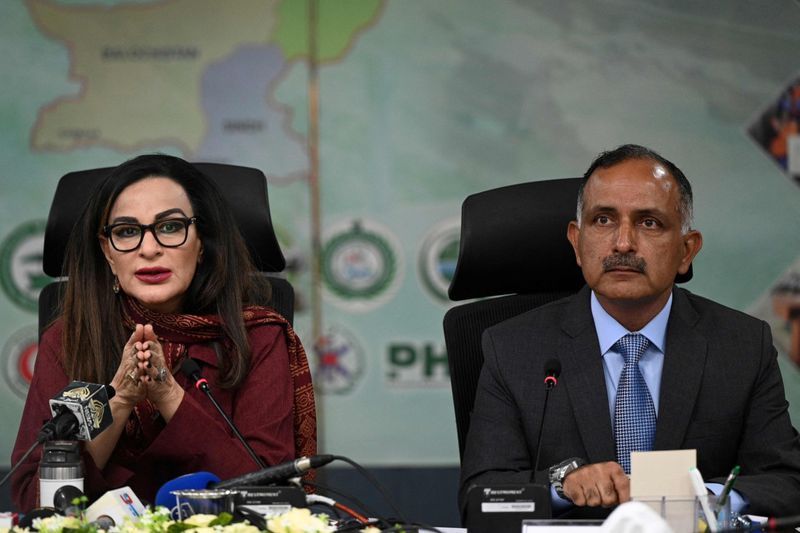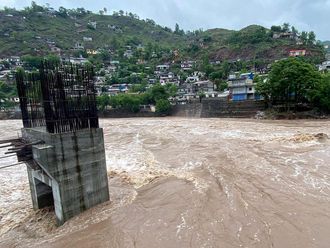
Islamabad: Biparjoy, a cyclone whose name means “disaster” in Bengali, is making its way across the Arabian Sea and is expected to make landfall as a “very severe cyclonic storm” on Thursday 11am in Pakistan.
Despite strong winds and rain, authorities said all people from vulnerable areas have been moved to safer places in the southern districts, including Thatta, Keti Bandar, Sajawal and Badin — regions that only last summer were hit by devastating floods that displaced thousands.
For many there, it was a second displacement in less than a year. People packed as many of their belongings as they could into their cars and left — either on their own or under troop escort — heading to relief camps set up inside government buildings and schools.
Pakistan Climate Minister Sherry Rehman urged people not to panic but work with the authorities, promising they would be taken to safer places.
Suspension of flights mulled
She said the threat of the cyclone making landfall in Karachi, Pakistan’s largest city with 20 million people, had been averted. She told reporters that Pakistan will consider suspending commercial flights when it assesses the situation on Thursday.
Nearly 80,000 people have been evacuated or have voluntarily moved away from danger zones, authorities said.
The International Rescue Committee said it is preparing to deploy emergency teams in Pakistan. The group’s country director, Shabnam Baluch, said an increase in cyclones due to climate change could result in more internal displacement “and this could have far-reaching implications on the future of Pakistan.”
Pakistan’s electricity minister, Khurram Dastgir, warned at a news conference of power outages once the cyclone makes landfall. He said transmission lines will likely be damaged and that the government has deployed 2,000 engineers to deal with the situation in the south.
On Tuesday, Pakistani Prime Minister Shahbaz Sharif ordered the evacuations from areas at risk and asked local authorities to arrange food, shelter and medical facilities for the displaced.
Sherry said that 80,000 people had been evacuated from the country’s southeastern coast, with 75 relief camps set up at schools and colleges.
She said fishermen had been warned to stay off the water and small aircraft were grounded, while flooding was possible in the megacity of Karachi, home to about 20 million people.
“We are following a policy of caution rather than wait and see,” she told reporters in Islamabad. “Our first priority is saving lives.”

The Pakistan Meteorological Department forecast gusts of up to 140 km/h in the southeastern province of Sindh, accompanied by a storm surge reaching 3.5 metres (11.5 feet).
Fishing has also been suspended along the Gujarat coast, with conditions expected to escalate from “rough to very rough” on Wednesday, to “high to phenomenal”.
A short distance from Jakhau port, some 200 Kutch tribal people from nearby Ashiravandh village sat on the floor at a single-storey local health centre that had been converted into a cyclone shelter.
Many worried
As night fell, men brewed tea on a kerosene stove in a corner while women, all in traditional dress, rocked their babies to sleep in wooden cradles as driving rain lashed the concrete walls of the centre.
Many were worried about their farm animals, which they had left behind.
Dhal Jetheeben Ladhaji, a pharmacist at the health centre, said 10 men had stayed behind to look after hundreds of cattle crucial to their village’s livelihood.
“We are terrified, we don’t know what will happen next,” Ladhaji, 40, told AFP.
“We are praying to God that the cyclone does not come, and that these people who are staying in the shelter can go back to their homes with smiles on their faces.”
Cyclones - the equivalent of hurricanes in the North Atlantic or typhoons in the Northwest Pacific - are a regular and deadly menace on the coast of the northern Indian Ocean, where tens of millions of people live.
Scientists have warned that storms are becoming more powerful as the world gets warmer with climate change.
Roxy Mathew Koll, a climate scientist at the Indian Institute of Tropical Meteorology, said cyclones derive their energy from warm waters, and that surface temperatures in the Arabian Sea were 1.2 to 1.4 degrees Celsius warmer than four decades ago.
“Rapid warming in the Arabian Sea, associated with global warming, tends to enhance the heat flux from the ocean to the atmosphere and favour more intense cyclones,” Koll told AFP.












